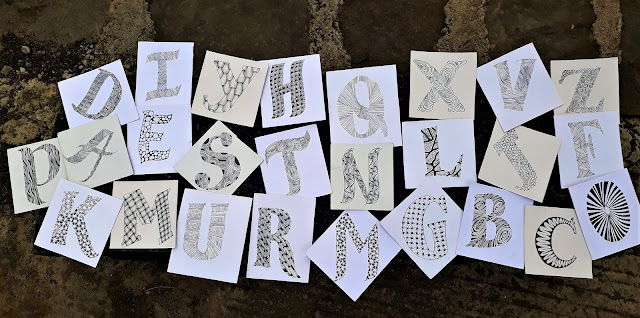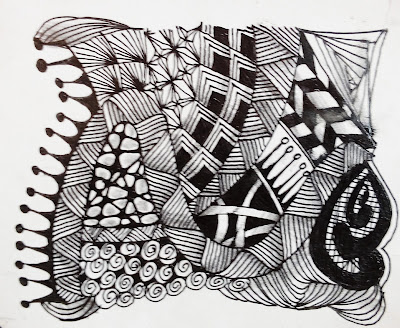The therapeutic art of Zentangles By Lekshmi Priya S. Art by Damko Wangyal (All the Alphabet)

 Doodle art has made its presence felt in our lives now more than ever. Admit it, each one of us have scribbled little nothings on the backside of our notebooks during the most boring of lectures, be it school or college. Now, we can find them on walls, coffee mugs, cushion covers, notebooks and even clothes, some being quirky while some satirical. But, whoever has heard of doodling being part of therapy.
Doodle art has made its presence felt in our lives now more than ever. Admit it, each one of us have scribbled little nothings on the backside of our notebooks during the most boring of lectures, be it school or college. Now, we can find them on walls, coffee mugs, cushion covers, notebooks and even clothes, some being quirky while some satirical. But, whoever has heard of doodling being part of therapy.
Zentangles, derived from the Japanese word ‘Zen’ for meditation and English word ‘Tangle’ finds its base in philosophy. The method was discovered by a US-based couple Maria Thomas and Rick Roberts in 2004, when Maria experienced the feelings of timelessness, freedom and well-being while filling up blank spaces on her calligraphic assignment with simple pen strokes—being completely engrossed and even losing the track of time. Rick thought of her experience as being in a meditative state of mind.
 Thus started the journey towards discovering the simple and elegant system called the Zentangle Method, where the repetitive simple pen strokes that offered no absolute meaning to the mind had the potency to arrest the mental activity or thoughts in the brain. The arrival to the alpha state of mind was deciphered, but the challenge that followed had been to make the entire process non-judgmental, where the mind was free to traverse a path that knew no bounds.
Thus started the journey towards discovering the simple and elegant system called the Zentangle Method, where the repetitive simple pen strokes that offered no absolute meaning to the mind had the potency to arrest the mental activity or thoughts in the brain. The arrival to the alpha state of mind was deciphered, but the challenge that followed had been to make the entire process non-judgmental, where the mind was free to traverse a path that knew no bounds.
With that the Zentangle Method was borne, adhering to few 'rules', making it different from a regular doodle. Meant to be completed using black ink on white paper, its creation goes unplanned, encouraging one to have no end goal in mind, rather allowing the pattern to reveal itself as one draws. Without the use of technology or special tools, the intention is to connect the makers to the timeless human endeavour of putting pen to paper. "The classic Zentangle art piece would flow out on paper without any intervention by the mind. Something that was created without any planning (by the mind), would never require any criteria for judgement during its creation", said Dilip P. Patel, India's first certified Zentangle teacher.
Having no set orientation that defines a start or an end, the Zentangle is intended to be abstract. Each stroke must be made deliberately, refraining from the use of erasers so that stray marks lead to the formation of interestingly unexpected patterns. Learning from one's own apparent mistakes can be foundations for new patterns and takes one to unexpected and exciting new directions. In the end, the purpose of creating a Zentangle is celebratory, making one heal and eventually celebrate the beauty of life.
The best part about making a Zentangle is that anyone can create one without the need of being an artist. While seeming intricate and complicated at first glance, a Zentangle creation is simple once you learn how it is done, more like finally knowing the secret behind a magic trick that had boggled your mind your whole life. Owing to its meditative attributes, the Zentangle Method is slowly being adopted as means for therapy, improving one's self-esteem and creativity while remaining a fun way to emerge calm and focused.
 "If practising the traditional meditation could be therapeutic, so can the practice of making Zentangles. Therapy is different for different people with different needs. To tackle stress, dejection, depression, or even pangs of loneliness, the mind requires to snap out of its reverie constructed out of negative thought processes. The more one dabbles in the Zentangle method, the more easier it is to pull out of the constant negativity buzzing in one's head," Patel adds.
"If practising the traditional meditation could be therapeutic, so can the practice of making Zentangles. Therapy is different for different people with different needs. To tackle stress, dejection, depression, or even pangs of loneliness, the mind requires to snap out of its reverie constructed out of negative thought processes. The more one dabbles in the Zentangle method, the more easier it is to pull out of the constant negativity buzzing in one's head," Patel adds.
With Facebook and YouTube having tutorials and DIY videos for almost anything, one is just a click away from learning how to make a Zentangle. The art form is slowly evolving and more people are becoming aware of this method. Patel and his wife Malathi have the credit of learning the method directly from the creators and are the first certified Zentangle teachers in the country. Based in Bengaluru, they organise workshops and classes on the Zentangle method in various cities in India.
Today, the art of Zentangle is emerging as a phenomenon in itself, used for not just creating interesting pieces of art but more importantly, healing and liberating people with an increased sense of personal well being, providing artistic satisfaction all along the way. Equating life to an art form, Maria and Rick had called the Zentangle Method an elegant metaphor for deliberate artistry in life. Little did they know that their discovery would come to receive such enormous acceptance and touch as many lives as it has.
























Comments
Post a Comment